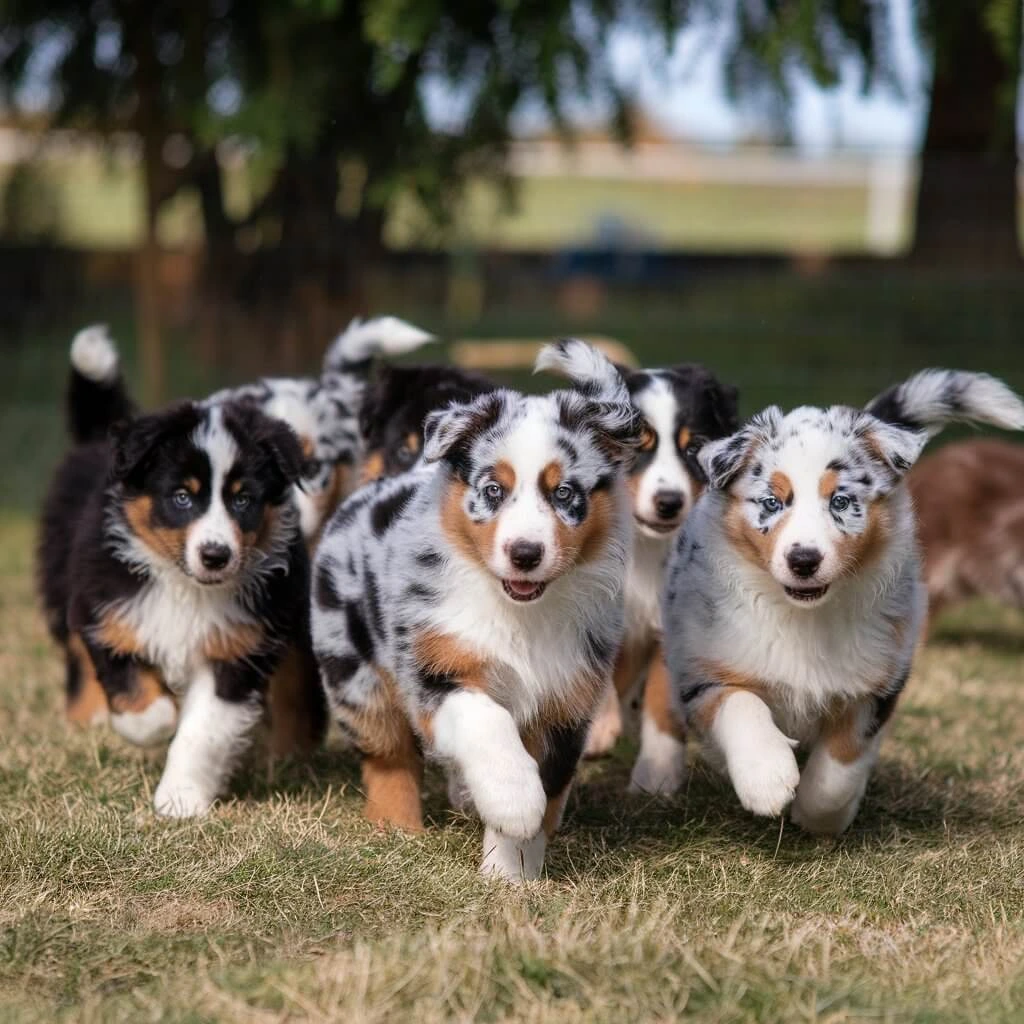
Are you looking for a furry addition to your family that’s full of energy, intelligence, and charm? Meet the Australian Shepherd puppy—a breed that’s as lovable as it is versatile. Known for their striking good looks and boundless enthusiasm, Australian Shepherd puppies have earned a reputation as one of the most family-friendly dog breeds.
With their playful demeanor, strong bond with family members, and ability to adapt to various lifestyles, these herding dogs are much more than just adorable companions. Whether you’re an active family who loves outdoor adventures or someone looking for a loyal four-legged friend, an Australian Shepherd puppy might be the perfect fit for your home.
In this blog post, we’ll explore what makes an Australian Shepherd puppy such a great choice for families, what you need to know before bringing one home, and how to ensure they thrive as part of your family. Let’s dive into the world of Australian Shepherds and discover why an Australian Shepherd puppy might just be your ideal canine companion!
Australian Shepherd Puppies: A Family-Friendly Breed
Learn more about caring for an Australian Shepherd puppy from the American Kennel Club.”
Temperament and Personality
Australian Shepherds are known for their remarkable intelligence and vibrant personalities, making them one of the most beloved breeds for families. Their high level of intelligence ranks them among the most trainable dog breeds, allowing them to quickly learn commands and adapt to household routines.
Loyalty is another defining trait of Australian Shepherds. They form deep bonds with their family members and are often described as “velcro dogs” due to their tendency to stay close to their loved ones. This devotion makes them excellent companions, particularly for families looking for a dog that will integrate seamlessly into their daily lives.
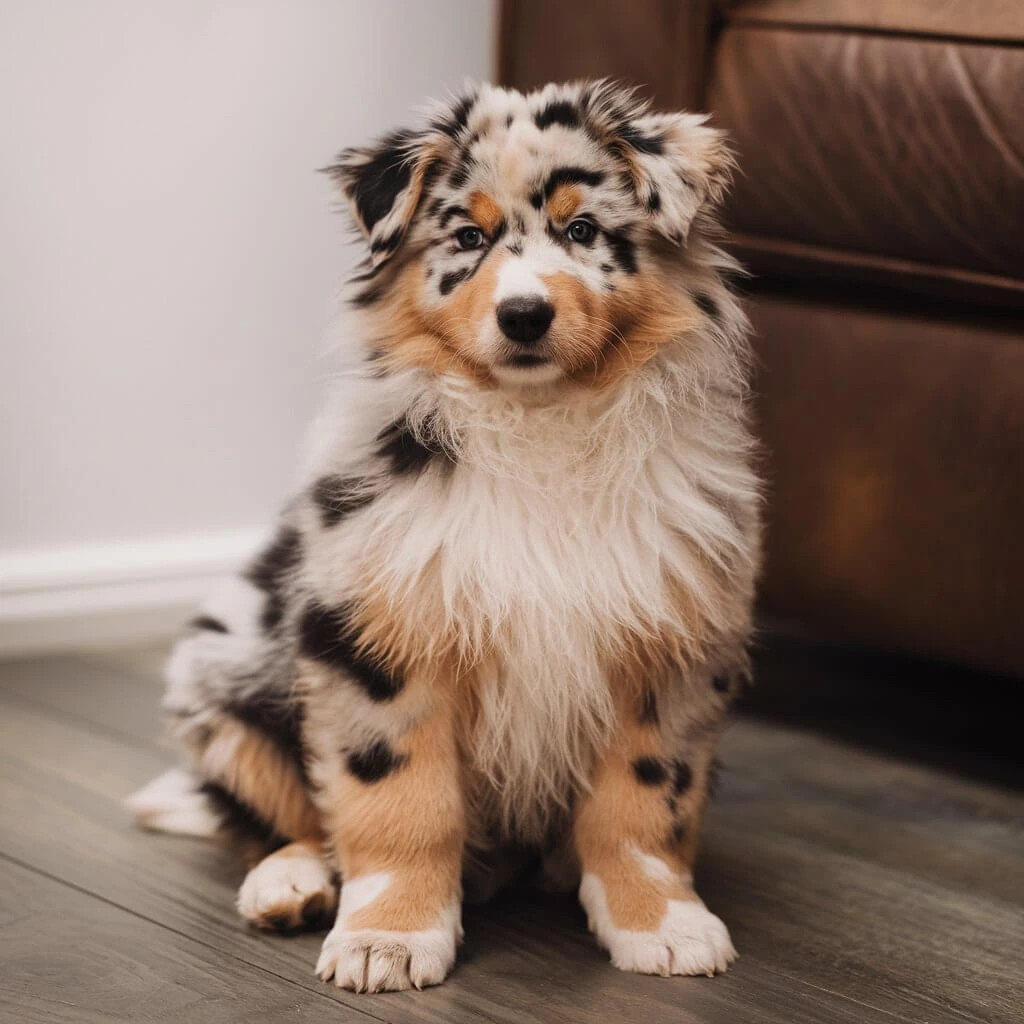
Playfulness is at the core of an Australian Shepherd’s character. They are naturally energetic and thrive in environments where they can participate in games, sports, or outdoor adventures. Their playful nature also makes them an instant hit with children, as they enjoy engaging in activities like fetch, frisbee, and tag.
While they are inherently protective, Australian Shepherds are not typically aggressive. They are naturally wary of strangers, which can make them effective watchdogs, but with proper socialization, they are friendly and approachable around new people and pets. This balance of protectiveness and amiability makes them a well-rounded choice for households seeking a loving yet alert dog.
In short, Australian Shepherds bring a perfect combination of intelligence, loyalty, playfulness, and protection to the table, making them a breed that captures hearts and fits seamlessly into family life.
Energy Levels of the Australian Shepherd puppy
Australian Shepherds are a high-energy breed that thrives on activity and engagement. Their boundless energy is one of the reasons they are best suited for active families or individuals who can meet their physical and mental exercise needs. These dogs are not couch potatoes; they are natural athletes who excel in a variety of physical activities, from hiking and running to agility training and herding trials.
Because of their working-dog heritage, Australian Shepherds require consistent daily exercise to stay happy and healthy. A long walk, a vigorous game of fetch, or even a swim can help burn off their abundant energy. Families who enjoy outdoor activities, such as camping, jogging, or playing in the backyard, will find the Australian Shepherd to be an enthusiastic companion who is always ready to join the fun.
Their stamina is impressive, and they often need more than a single walk around the block to feel satisfied. Without adequate outlets for their energy, Australian Shepherds can become restless and may resort to undesirable behaviors such as chewing, digging, or excessive barking. This makes it essential for prospective owners to commit to a lifestyle that incorporates plenty of physical activity.
What sets Australian Shepherds apart is not just their physical energy but also their mental energy. These dogs crave challenges that stimulate their sharp minds, such as obedience training, puzzle toys, or interactive games. Engaging both their body and mind ensures they remain balanced and well-adjusted members of the family.
For families who are active and enjoy spending time outdoors, Australian Shepherds are the perfect match. Their zest for life and eagerness to participate in activities make them an ideal choice for those seeking a dynamic and engaging canine companion.
Kid-Friendly Nature of the Australian Shepherd puppies
Australian Shepherds are renowned for their friendly and affectionate disposition, especially toward children. Their playful energy and enthusiasm make them a natural fit for families with kids, as they enjoy engaging in games and outdoor activities. Whether it’s playing a game of tag in the backyard or joining in a family hike, Australian Shepherds are eager to be a part of the action.
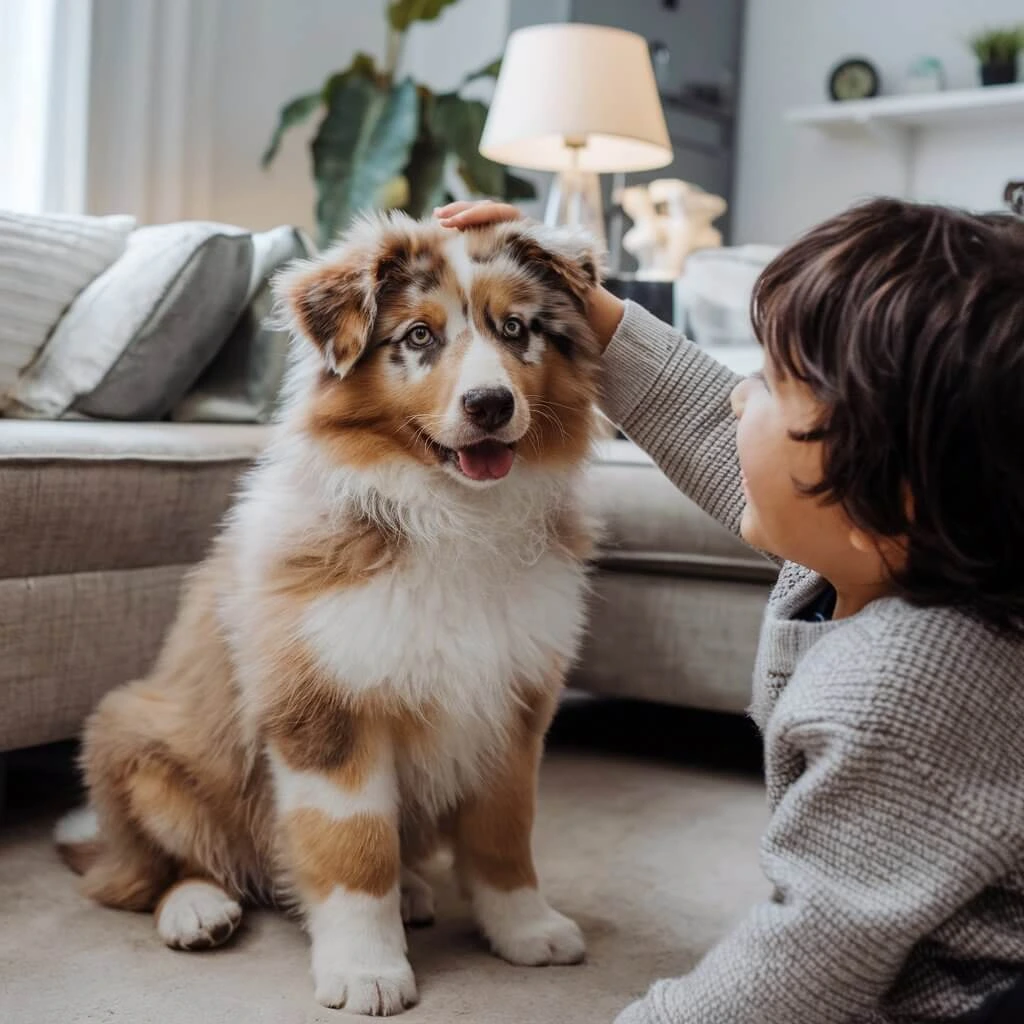
What makes them particularly kid-friendly is their gentle and protective nature. These dogs often develop strong bonds with the younger members of the household and instinctively take on a “nanny” role. They are highly perceptive and seem to understand the need to be more gentle with small children, making them a safe choice for families with toddlers.
Australian Shepherds’ high energy levels align perfectly with the liveliness of children, creating endless opportunities for shared activities. Their intelligence also plays a role, as they can quickly learn and adapt to household rules, ensuring they interact appropriately with kids of all ages.
However, as with any breed, supervision is essential, especially with younger children. Teaching kids how to respect the dog’s space and boundaries helps foster a positive relationship. Early socialization and training ensure that the Australian Shepherd’s playful energy is well-directed, reducing the likelihood of overexcitement or unintentional rough play.
In essence, Australian Shepherds are fantastic companions for kids, offering a balance of playful energy, affectionate loyalty, and gentle protectiveness. They bring joy and vitality to family life while creating cherished memories for years to come.
Compatibility With Other Pets
Australian Shepherds are highly adaptable and tend to get along well with other pets when properly socialized. Their friendly demeanor and pack-oriented mindset make them natural companions for households with multiple animals. Whether it’s another dog, a cat, or even smaller pets like rabbits, Australian Shepherds can coexist harmoniously with the right introductions and guidance.
Their herding instincts, however, can sometimes come into play. Australian Shepherds may attempt to “herd” other animals in the home, especially if they are smaller or more timid. While this behavior is rarely aggressive, it can be overwhelming for some pets. Early training and redirection can help manage these instincts, ensuring peaceful interactions.
When it comes to other dogs, Australian Shepherds are generally sociable and enjoy playing with canine companions. They tend to thrive in environments where they have a buddy to share their energy and activities with. For families with cats, Australian Shepherds can also learn to coexist peacefully, especially if they are introduced at a young age and taught to respect the cat’s boundaries.
One of the keys to success in multi-pet households is early and consistent socialization. Exposing your Australian Shepherd to other animals in a controlled and positive way helps them build confidence and learn appropriate behaviors. With the right foundation, these intelligent and adaptable dogs can form strong bonds with their fellow furry family members.
In conclusion, Australian Shepherds’ friendly and adaptable nature makes them excellent candidates for homes with multiple pets. Their ability to form close relationships with other animals adds to their appeal as a well-rounded family companion.
Why Choose an Australian Shepherd puppy for Your Lifestyle
Active Lifestyles
Australian Shepherds are perfectly suited for families who lead active and adventurous lives. With their boundless energy and athleticism, they are happiest when they have opportunities to join in high-energy activities. From hiking mountain trails to long-distance jogging or even casual backyard play, Australian Shepherds are always eager to be part of the action.
These dogs are natural athletes, making them excellent partners for structured sports such as agility, flyball, and frisbee competitions. Their stamina and agility allow them to excel in almost any physical activity. If your family loves camping, kayaking, or other outdoor adventures, an Australian Shepherd will enthusiastically accompany you, adding joy and companionship to your excursions.
Moreover, Australian Shepherds thrive in homes where their active lifestyles can be a regular routine. Families who prioritize outdoor time and exercise will find this breed to be a perfect match, as they not only keep up but inspire everyone to stay on their feet. By including your Aussie in your adventures, you create a bond that fosters mutual happiness and fulfillment.
Mental Stimulation Needs
Australian Shepherds are exceptionally intelligent dogs, and their need for mental stimulation is as crucial as their physical exercise. Without proper challenges for their sharp minds, these clever dogs can become bored, which may lead to undesirable behaviors such as chewing, digging, or excessive barking.
One of the best ways to meet their mental stimulation needs is through training. They excel in learning new commands, tricks, and tasks, and they enjoy being challenged with activities that require problem-solving. Advanced obedience training, herding trials, and even fun games like “find the treat” are perfect outlets for their mental energy.
Interactive puzzle toys and enrichment activities are also ideal for keeping their brains engaged. Games that involve fetching specific items, playing hide-and-seek, or navigating obstacle courses are great examples of ways to provide variety and stimulation.
Families who dedicate time to both mental and physical exercises for their Australian Shepherd will find that the dog’s intelligence, curiosity, and energy levels are beautifully balanced. Keeping their minds sharp is key to having a happy, well-rounded companion.
Affectionate Companions
Australian Shepherds are renowned for their affectionate and loyal nature, making them exceptional companions for families of all sizes. They form deep emotional bonds with their owners and are often happiest when they are in close proximity to their loved ones.
Their affectionate personality shines through in everyday interactions. Whether they are leaning against you while you relax, curling up beside you after an active day, or following you around the house, Australian Shepherds thrive on human connection. This breed is often described as being highly “people-oriented,” making them ideal for families who want a dog that will be an integral part of their daily lives.
In addition to their loyalty, Australian Shepherds are incredibly perceptive. They can often sense their owners’ emotions and provide comfort during tough times, making them excellent emotional support animals. Their gentle and loving nature extends to children, adults, and seniors alike, ensuring they form meaningful relationships with every family member.
Adaptability
Australian Shepherds are impressively adaptable dogs that can thrive in a variety of environments and lifestyles. While they naturally enjoy open spaces where they can run and play, they can also adjust to suburban or even urban living if their exercise and mental stimulation needs are met.
In rural settings, Australian Shepherds flourish as working dogs, using their herding instincts and energy to help on farms or ranches. In suburban homes, they fit right in with families who enjoy taking them on walks, playing in the backyard, or engaging in regular outings to parks. Even in urban apartments, Australian Shepherds can adapt well as long as they receive ample exercise, mental challenges, and time outdoors.
Their versatility extends to family dynamics as well. They can easily fit into households with children, single owners, or multi-pet environments, provided they are given the love, attention, and training they need. Their willingness to adapt is a testament to their intelligence and eagerness to please, making them a great choice for a wide range of families.
Key Considerations Before Getting an Australian Shepherd Puppy
Exercise Requirements
Australian Shepherds are one of the most energetic dog breeds, requiring daily exercise to keep them happy, healthy, and well-behaved. A simple walk around the block won’t suffice for these high-energy dogs. They need at least 1-2 hours of vigorous activity every day to burn off their natural enthusiasm.
Ideal forms of exercise include long walks, runs, hiking, or engaging games like fetch or frisbee. These dogs also excel in more structured physical activities, such as agility courses, obedience competitions, and herding trials. For active families, incorporating your Australian Shepherd into your daily routines, such as jogging or cycling, can be a great way to meet their physical needs.
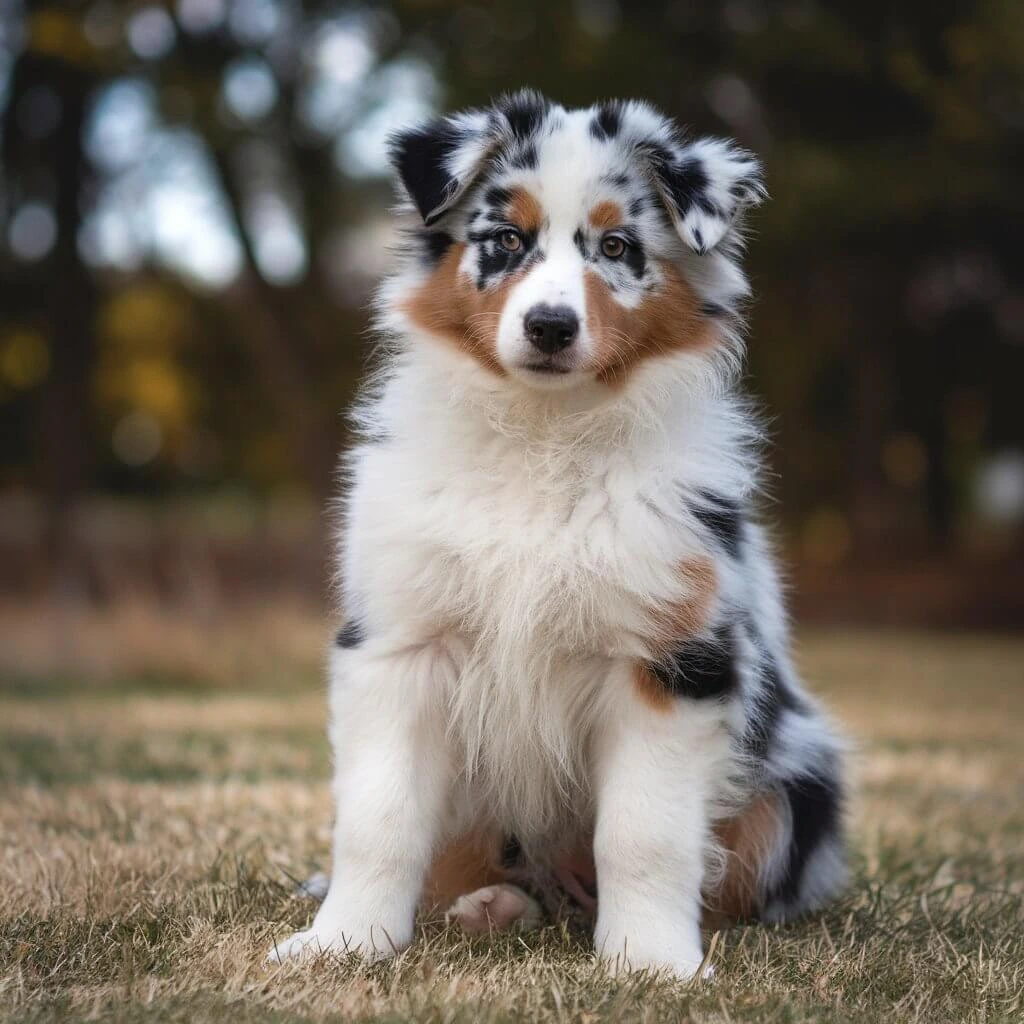
Without adequate exercise, Australian Shepherds may become restless and resort to undesirable behaviors, such as excessive barking, digging, or chewing. Consistency is key—regular activity not only helps to expend their energy but also strengthens their bond with their owners.
Exercise doesn’t have to be just physical; mental stimulation is equally important. Combining physical activities with tasks that challenge their intelligence, such as fetch with commands or hide-and-seek games, will ensure they remain well-balanced and content.
Grooming Needs
The Australian Shepherd’s beautiful double coat is one of its most distinctive features, but it also comes with specific grooming requirements to keep it in top condition. Their coat consists of a weather-resistant outer layer and a soft undercoat, which means regular grooming is essential to manage shedding and maintain their health.
Brushing is a must for this breed, ideally 2-3 times a week, to remove loose hair, prevent matting, and keep their coat looking sleek and shiny. During shedding seasons—typically in spring and fall—more frequent brushing may be required to manage the heavier fur loss.
Bathing should be done as needed, usually every few months or when your Australian Shepherd gets particularly dirty. Overbathing can strip the natural oils from their coat, so it’s important not to overdo it.
Their grooming routine also includes nail trimming, ear cleaning, and dental care. Keeping their nails trimmed prevents discomfort, while regular ear checks help avoid infections, especially since their floppy ears can trap dirt and moisture.
With proper grooming, not only will your Australian Shepherd look their best, but you’ll also be helping them stay comfortable and healthy throughout the year.
Training and Socialization
Australian Shepherds are highly intelligent and eager to please, which makes them incredibly trainable. However, their intelligence also means they require consistent and structured training from an early age. Without proper guidance, their sharp minds can lead to stubbornness or undesirable behaviors.
Positive reinforcement methods, such as treats, praise, and play, work exceptionally well with this breed. Early training should focus on basic commands like sit, stay, and come, but Australian Shepherds are also capable of learning advanced skills, tricks, and even tasks like fetching specific items or herding livestock.
Socialization is equally important for an Australian Shepherd puppy. Exposing them to a variety of people, environments, and other animals helps them develop into well-mannered and confident adults. Trips to the park, puppy classes, and playdates with other dogs are excellent ways to encourage positive social interactions.
Since they have a natural tendency to herd, training can help redirect this behavior away from small children or other pets in the household. Consistency, patience, and mental stimulation are key to raising a well-rounded Australian Shepherd.
Space Needs for Shepherd puppy
While Australian Shepherds are adaptable, they thrive in environments where they have space to move and explore. Ideally, they are suited for homes with large yards, farms, or rural settings where they can run freely and engage in physical activities.
That said, they can also adapt to suburban or even urban living as long as their exercise and mental stimulation needs are met. Families living in apartments or homes without a yard should commit to daily outings to parks, trails, or other open spaces to give their Aussie ample opportunities to release their energy.
Australian Shepherds do best in households where they are not confined for long periods. Their active nature and intelligence require regular engagement, so owners must ensure that their living environment supports their energetic lifestyle.
If you’re considering an Australian Shepherd, assess whether your home and schedule can accommodate their space and activity requirements. With the right balance of physical and mental exercise, they can thrive in almost any setting, as long as their needs are met.
Tips for Caring for Your Australian Shepherd Puppy
Nutrition Tips
Providing the right nutrition is essential for the health and growth of your Australian Shepherd puppy. A well-balanced diet tailored to their specific needs helps fuel their high energy levels and supports their physical development.
Look for high-quality dog food with real meat as the primary ingredient, supplemented with wholesome grains, vegetables, and healthy fats. The Puppy needs a diet rich in protein to support muscle development and enough calcium and phosphorus for healthy bones. Consult with your veterinarian to select food formulated specifically for active breeds like Australian Shepherds.
Portion control is crucial to prevent overeating or undernourishment. Follow the feeding guidelines provided by the food manufacturer and adjust based on your puppy’s age, weight, and activity level. Puppies typically require more frequent meals—3-4 times a day—before transitioning to 2 meals as they grow older.
Treats can be a valuable part of training but should be given in moderation. Opt for healthy, low-calorie treats and avoid feeding them table scraps, which can lead to obesity or digestive issues.
Finally, always provide fresh, clean water to keep your Australian Shepherd puppy hydrated, especially after exercise. Their active nature means they burn calories quickly, so proper nutrition is key to maintaining their energy and overall well-being.
Training Techniques
Australian Shepherds are exceptionally intelligent and eager to learn, making them highly trainable when approached with the right techniques. Positive reinforcement is the most effective method for this breed, as they respond well to praise, treats, and play.
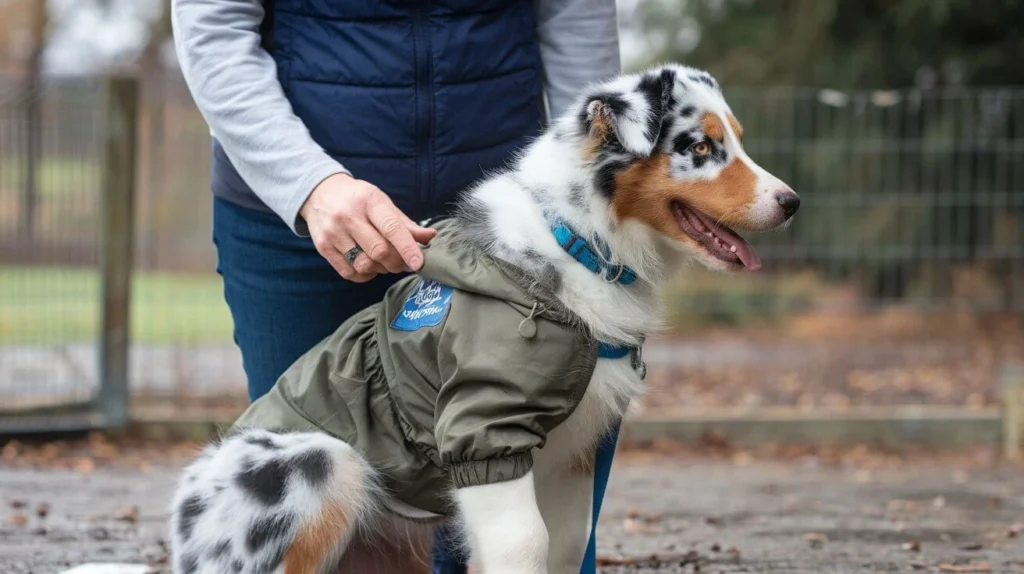
Begin training as early as possible, starting with basic commands like sit, stay, and come. Short, consistent sessions are best for keeping their attention, as their energy can sometimes make long sessions counterproductive. Repetition and consistency are key to reinforcing good behavior and avoiding confusion.
As they master the basics, you can introduce more advanced commands and tricks. Australian Shepherds enjoy challenges, so incorporating agility training, scent work, or herding tasks can keep them mentally stimulated and focused.
It’s important to establish boundaries early on, as their intelligence can sometimes lead to stubbornness. Using clear, firm commands helps them understand expectations, while patience ensures a positive learning experience. Avoid harsh punishments, as this can damage trust and make training less effective.
Crate training and leash training are also essential components of early training, helping them feel secure and behave well in different environments. With consistent effort, Australian Shepherds can become obedient, well-mannered companions who thrive on learning new things.
Socialization with Kids and Pets
Socialization is a critical step in raising a well-adjusted Australian Shepherd, ensuring they are confident and comfortable around children, other pets, and various environments. Start introducing your puppy to new experiences as early as possible to help them develop positive behaviors and reduce fear or anxiety.
When socializing with children, it’s important to supervise interactions, especially with younger kids who may not yet understand how to handle a dog gently. Teach children to respect the dog’s space, avoid pulling on ears or tails, and engage in calm, positive play. Australian Shepherds typically bond quickly with kids, becoming protective and playful companions.
When introducing your puppy to other pets, start with controlled, low-stress meetings. Keep both animals on a leash initially and observe their body language for signs of stress or aggression. Gradually increase their time together, allowing them to interact at their own pace.
Visits to dog parks, puppy classes, or playdates with other dogs are great ways to expose your Aussie to new canine friends and teach them appropriate social behavior. Early and frequent exposure to various situations, including car rides, noisy environments, and different types of people, will help your Australian Shepherd grow into a confident and sociable adult.
Toys and Activities They Love
Australian Shepherds are energetic and intelligent dogs that thrive on activities and toys that engage both their bodies and minds. Providing a variety of stimulating toys is essential to keeping them entertained and preventing boredom.
Interactive toys, such as treat-dispensing puzzles or food-motivated games, are excellent for mental stimulation. These types of toys challenge their problem-solving skills while rewarding their effort, keeping them engaged for extended periods.
Australian Shepherds also love physical toys like frisbees, tennis balls, and tug ropes. Fetch is a favorite game for this breed, allowing them to burn off energy while enjoying bonding time with their owners. Tug-of-war games are another way to provide physical exercise while satisfying their playful instincts.
For independent play, durable chew toys or rubber bones can keep them occupied while promoting healthy teeth and gums. Choose toys made from high-quality, non-toxic materials that can withstand their strong jaws and active playstyle.
Activities like agility courses, hide-and-seek, or herding exercises are fantastic ways to combine physical and mental stimulation. Rotating toys and introducing new activities regularly helps maintain their interest and ensures they remain happy and engaged.
By catering to their natural instincts and energy levels, you’ll not only keep your Australian Shepherd entertained but also nurture a stronger bond through shared play.
Real-Life Stories: Families and Their Australian Shepherds
Case Study 1: How an Active Family Found Their puppy Perfect Match
The Smith family, an outdoorsy group with two young children, wanted a dog that could keep up with their energetic lifestyle. After researching various breeds, they decided to adopt an Australian Shepherd puppy named Max.
From the start, Max proved to be the perfect match for their active household. He quickly bonded with the children, becoming their constant companion during playtime and outdoor adventures. The Smiths found that Max’s high energy levels aligned perfectly with their weekend hikes, bike rides, and backyard games of frisbee.
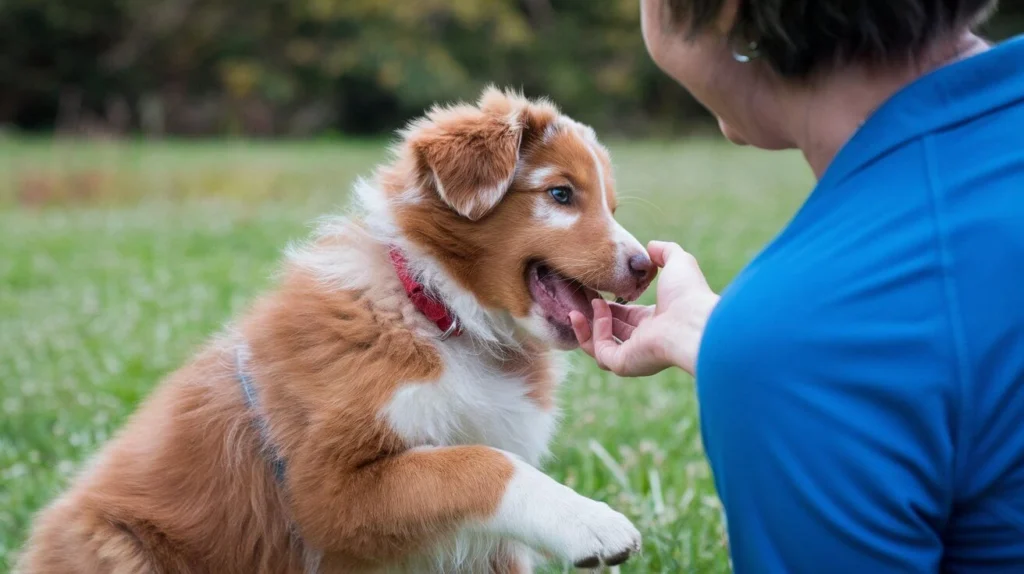
Max also excelled in training, learning basic commands in record time and even mastering fun tricks like jumping through hoops. The Smiths incorporated agility exercises into his routine, which not only kept him physically fit but also strengthened their bond as a family.
Four years later, Max remains an integral part of the Smith family, bringing joy, energy, and love into their lives. The Smiths credit Max’s intelligence, loyalty, and playful spirit for enriching their family dynamic and encouraging them to spend more time outdoors together.
Case Study 2: A Family with Kids Shares Their Experience with Their Aussie
The Hernandez family, who have three children ranging from 5 to 12 years old, had always dreamed of getting a dog. They chose Luna, a playful Australian Shepherd, after hearing about the breed’s reputation for being great with kids.
Luna immediately became a favorite among the children, who adored her affectionate and playful personality. She quickly adapted to their lively home, happily joining in their backyard games and patiently sitting through storytime sessions with the youngest child. Her gentle nature made her a perfect playmate for the kids, and her protective instincts gave the Hernandez parents peace of mind.
Despite Luna’s boundless energy, the Hernandez family appreciated her adaptability. On busy school days, Luna contentedly lounged around the house, but on weekends, she came alive during family hikes and visits to the local dog park. Luna’s friendly demeanor even made her a hit with the neighbors, further solidifying her place as a cherished member of the community.
The Hernandez family agrees that bringing Luna into their home was one of the best decisions they ever made. Her playful yet gentle personality has not only deepened the siblings’ bond but also created countless happy memories for the entire family.
Case Study 3: Adopting vs. Buying – A Personal Perspective
When the Johnsons decided to get a dog, they faced the common dilemma: Should they buy from a breeder or adopt? After thorough research, they chose to adopt an Australian Shepherd named Ruby from a local rescue organization.
Ruby, a one-year-old Aussie, had been surrendered by her previous owner due to lifestyle changes. From the moment she joined the Johnson household, Ruby’s gratitude and loyalty were evident. Although she needed some extra training to adapt to her new environment, her intelligence and eagerness to please made the process smooth and rewarding.
The Johnsons found that adopting Ruby not only saved her life but also enriched their own. Her playful energy brought joy to their daily routines, and her affectionate nature created a deep emotional bond with each family member. The family also appreciated the opportunity to give a second chance to a dog in need, a decision that filled their hearts with pride and happiness.
Their experience underscores the importance of considering adoption. Ruby’s story is a testament to how rescued Australian Shepherds can thrive in a loving home, proving that the adoption route can be just as fulfilling as buying from a breeder.
Conclusion
Australian Shepherds are exceptional companions, combining intelligence, energy, loyalty, and affection into one remarkable package. Their vibrant personalities and adaptability make them an excellent choice for families, particularly those who enjoy an active lifestyle and are ready to invest time in their training and care.
Throughout this post, we’ve explored their family-friendly temperament, high energy levels, and deep bonds with their owners. We’ve also highlighted important considerations like exercise requirements, grooming needs, and the value of early training and socialization. By understanding these aspects, you can determine if an Australian Shepherd is the perfect addition to your family.
However, owning an Australian Shepherd puppy isn’t a decision to take lightly. Their high energy levels and mental stimulation needs require a committed owner who can provide a loving and structured environment. If you’re prepared to embrace the joys and challenges of raising this amazing breed, an Australian Shepherd will reward you with years of love, loyalty, and unforgettable memories.
We encourage you to share this post with friends or family members considering adding a dog to their home. If you already have an Australian Shepherd, we’d love to hear about your experiences. Leave a comment below or share your photos and stories—your insights can help others discover the joy of having an Aussie in their lives.
By choosing an Australian Shepherd, you’re not just welcoming a pet—you’re gaining a devoted companion who will bring endless joy and energy to your family.
To Learn more about other pets visit our Home page from here.

2 thoughts on “Why an Australian Shepherd Puppy Might Be Perfect for Your Family”
Comments are closed.